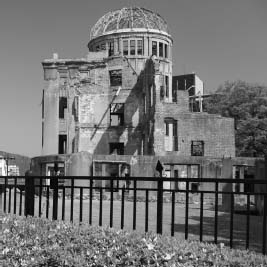ShintoHistory and Sources |
How would you sum up the history of Shinto? |
Beliefs now associated with the religious tradition called Shinto originated long before anyone ever referred to them as “the Way of the Kami.” Archaeological evidence points to various forms of nature worship, ancestor veneration, shamanistic rituals, and animistic beliefs in an agricultural society during the neolithic (7000-250 B.C.E.) and bronze-iron (250 B.C.E.-100 C.E.) ages. Primitive shrines dedicated to the community or clan deities called ujigami appeared between 100 and 552 C.E. Sometime in the later sixth century C.E., after the arrival of Butsu-do or “the Way of the Buddha,” Japanese distinguished indigenous beliefs from the imported tradition by inventing a name for it. During the Nara period (710-794), the Nakatomi clan served as priests of a nascent imperial Shinto whose earliest major shrines were those of Ise and Izumo. By 737 Shinto shrines numbered over three thousand, one in four enjoying direct government support.
The Fujiwara clan founded the important Kasuga shrine in Nara, the first capital. Kasuga was destined to play a critical role in the development of a hybrid of Buddhism and Shinto through its relationship with the nearby Buddhist temple of Todaiji. Throughout the Heian period (794-1185), with the capital newly established at Kyoto, Shinto’s fortunes were intimately bound up with developments in Buddhism. Theologians on both sides devised theories designed to fit the two belief systems together, thereby inventing “Dual Shinto,” a blend of both.
The Kamakura period (1185-1333) witnessed the rise of feudal lords (daimyo) and a samurai warrior caste under a shogun (“throne field marshal”) of the Minamoto family, which had toppled the Fujiwara clan. The Samurai code, bushido, was a blend of Confucian aristocratic conservatism, Buddhist mental discipline, and Shinto patriotism. Under the Minamoto the two chief kami were Sugawara Michizane, patron of literary and social concerns, and Hachiman, kami of war. Shinto grew as a popular religious tradition during the Muromachi/Ashikaga period (1333-1568, the first name referring to the capital outside Kyoto and the second to the clan in power) with imperial patronage of pilgrimage to Ise shrine.
Pre- and early modern developments during the Momoyama/Azuchi (1568-1615) and Edo/Tokugawa periods (1615-1867) included Shinto’s steady ascendancy over Buddhism and identification with the political power of dictatorial shoguns. Eighteenth- and nineteenth-century Japanese isolationism went hand in hand with attempts to rid Shinto of foreign elements. That culminated in the Meiji Reform, ushering in the modern period (1868-1945) and restoring the emperor to divine status. World War II called Shinto’s imperial theology into question and saw a return of popular sectarian movements.
| Date | Event | |
| 660 B.C.E. | Jimmu Tenno, first human emperor, divine son of Sun goddess Amaterasu. | |
| c. 100-552 C.E. | Primitive Shinto shrines dedicated to clan deities (Ujigami) appear and spread. | |
| c. 620 | Kojiki, Records of Ancient Matters. | |
| 710-784 | First permanent capital established at Nara; introduction of Confucianism, religious Daoism, and Buddhism; Shinto formally organized as all religions interact. | |
| 715 | Buddhist temple annexed to a Shinto shrine. | |
| 720 | Nihongi or Nihon Shoki, Chronicles of Japan, Shinto’s main “scriptures.” | |
| 737 | Shinto shrines number three thousand. | |
| 750 | An image of the Shinto war kami Hachiman is transported from the Shrine at Usa to Todaiji, in Nara. | |
| 794—1185 | Heian period in Japan: Shinto’s fortunes intimately bound up with the developments in Buddhism; foundation of Shingon and Tendai sects of Buddhism. | |
| 845—903 | Sugawara Michizane, poet-calligrapher, becomes a kami. | |
| 901—923 | Engi-shiki, or Institutes of the Engi Era promulgated by Heian emperor. | |
| 1185—1333 | Japanese Buddhist and Shinto theologians devise theories designed to blend the two belief systems, thus inventing “Dual (ryobu) Shinto.” | |
| 1333—1568 | Muromachi period in Japan; Shinto grows as popular religion. | |
| 1600—1868 | Tokugawa period in Japan; Confucianism gains influence in the Japanese Imperial government. | |
| 1622—1685 | Yamaga Soko, Japanese Confucian scholar and military theorist, originator of the way of the warrior, bushi-do, blending Shinto and Buddhist themes. | |
| 1669—1736 | Life of Kada no Azumamaro, considered the founder of the school of National Learning or Kokugaku. | |
| 1697—1769 | Life of Kamo no Mabuchi, applies philological methods to classical Japanese prayer. | |
| 1730—1801 | Life of Motoori Morinaga, regarded Shinto’s best scholarly mind. | |
| 1763—1843 | Life of Hirata Atsutane, influential exponent of Kokugaku. | |
| 1868 | Dual Shinto becomes dominant form of Shinto. | |
| 1868 | Japanese impose a system of devotion to the emperor, a kind of State Creed. | |
| 1868—1871 | Japanese persecution of Buddhists by Meiji emperor. | |
| 1868—1945 | Confucians play important role in the Meiji Reform; restoration of the emperor’s divine status. | |
| 1869 | Founding of Tokyo’s Yasukuni Shrine as memorial to war dead. | |
| 1900 | Shrine Shinto no longer considered a religion, but a universally binding attitude of reverence for the emperor. | |
| 1945 | Supreme Commander of Allied Powers, General Douglas McArthur, issues the Shinto Directive; emperor no longer considered divine. | |
| 1989 | Death of last “divine” Japanese emperor, Hirohito, ending the Showa era. | |
| 2012 | Shinto remains dominant “cultural” code of Japan, blending residual Confucian values, symbolizing much of Japanese heritage. |

The remains of the Hiroshima Genbaku Dome, where the Americans dropped the first of two atomic bombs that ended the war, is now a memorial for the tens of thousands who died. The end of World War II also marked the end of the days when the Japanese revered the emperor as an infalable, divine leader.
